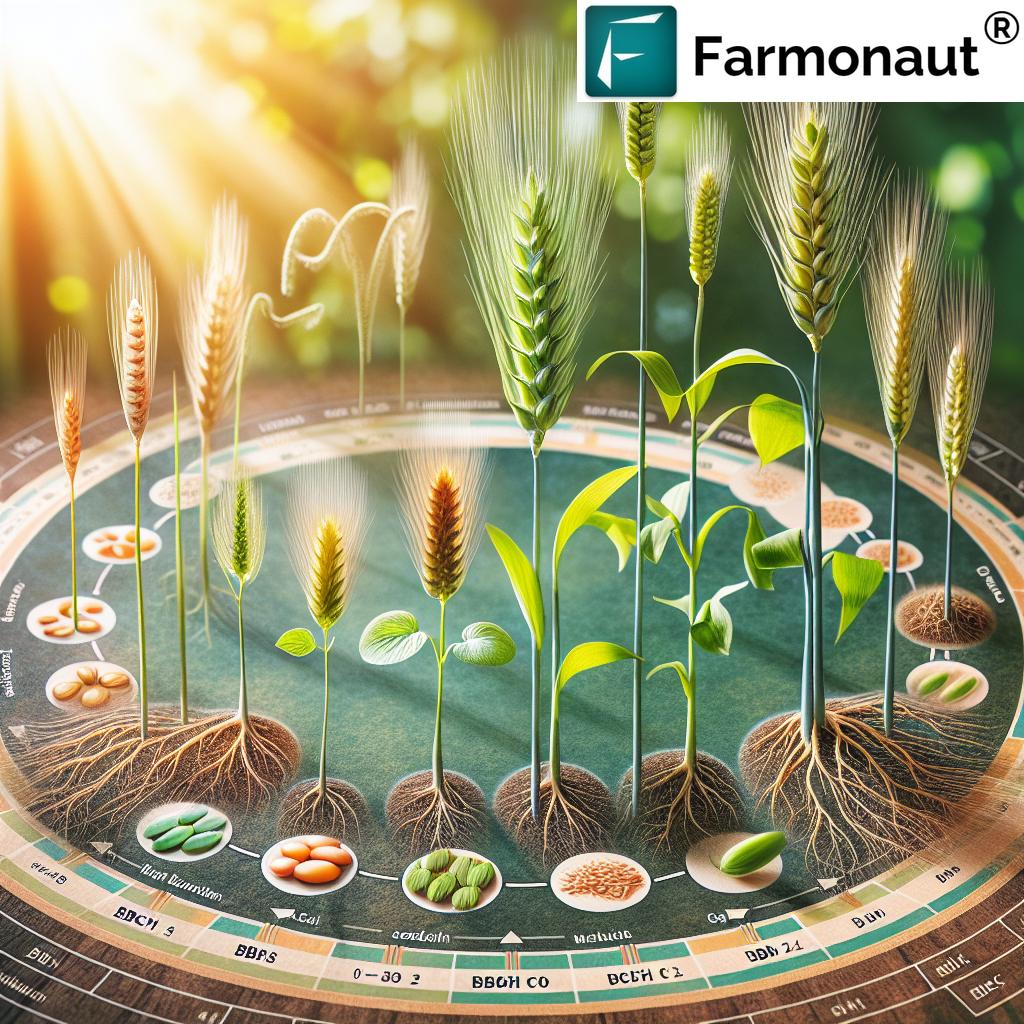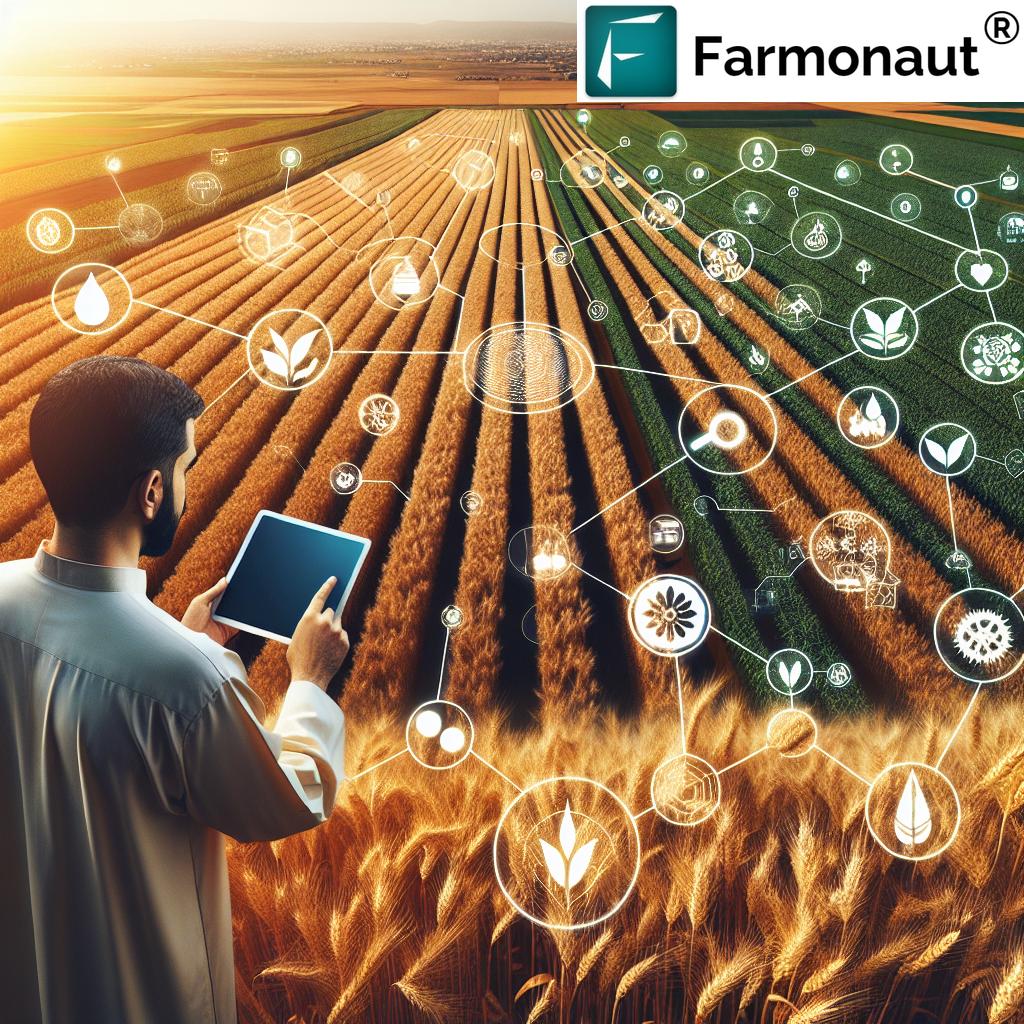
Mastering Wheat Growth Stages: A Comprehensive Guide to Crop Monitoring and Management for Optimal Yields
As agricultural technology experts at Farmonaut, we understand the critical importance of monitoring and managing wheat growth stages for achieving optimal yields. In this comprehensive guide, we’ll explore the intricate journey of wheat from seed to harvest, detailing each growth stage and providing insights on how to leverage modern technology for precision agriculture.
Understanding Wheat Growth Stages
Wheat, one of the world’s most important cereal crops, undergoes a series of well-defined growth stages from planting to harvest. Understanding these stages is crucial for effective crop management and maximizing yields. Let’s delve into the key phases of wheat development:
1. Germination and Emergence
The journey begins with the germination of wheat seeds. Under favorable soil moisture and temperature conditions, the seed absorbs water and begins to sprout. This stage is critical, as it sets the foundation for the entire crop’s development.
- Optimal soil moisture: 50-60% of field capacity
- Ideal temperature range: 12-25°C (54-77°F)
- Duration: 5-10 days, depending on conditions
Emergence follows germination, as the first leaf pushes through the soil surface. This stage is crucial for establishing a uniform plant stand.
2. Tillering
Tillering is a pivotal stage in wheat development, where the plant produces additional shoots or tillers from the main stem. This process is essential for increasing the potential number of grain-bearing heads.
- Begins when the plant has 3-4 leaves
- Optimal temperature: 15-20°C (59-68°F)
- Adequate nitrogen and phosphorus are crucial at this stage
At Farmonaut, we use satellite imagery to monitor crop density and uniformity during tillering, helping farmers make informed decisions about fertilizer application and pest control.
3. Stem Elongation
Following tillering, the wheat plant enters the stem elongation phase. During this stage, the stem grows rapidly, and the developing head begins to move upwards within the stem.
- Characterized by the appearance of nodes on the stem
- Critical period for nitrogen uptake
- Water demand increases significantly
Our satellite-based monitoring system at Farmonaut can detect changes in crop vigor during stem elongation, alerting farmers to potential nutrient deficiencies or water stress.
4. Booting and Heading
The booting stage occurs when the developing head is enclosed within the sheath of the flag leaf. This is followed by heading, where the head emerges from the boot.
- Booting typically begins 6-8 weeks after crop emergence
- Heading is a critical stage for determining final grain number
- Susceptible to heat and moisture stress
Using our advanced imaging technology, we can provide farmers with detailed insights into crop development during these crucial stages.
5. Flowering (Anthesis)
Flowering, or anthesis, is a brief but critical stage in wheat development. During this period, pollination occurs, and the number of fertile florets is determined.
- Typically lasts 4-5 days
- Optimal temperature range: 18-24°C (64-75°F)
- Highly sensitive to environmental stresses
Our real-time weather monitoring and forecasting services help farmers anticipate and mitigate risks during this sensitive phase.
6. Grain Filling and Ripening
The final stages of wheat development involve grain filling and ripening. During grain filling, the kernels accumulate starch and proteins. As the grain matures, it begins to lose moisture and harden.
- Grain filling typically lasts 20-30 days
- Moisture content decreases from about 80% to 20-25% at harvest
- Temperature and water availability significantly impact grain quality and yield
At Farmonaut, we provide detailed crop health maps and yield prediction models to help farmers optimize their harvest timing and maximize grain quality.
The BBCH Scale: A Universal Language for Crop Development
To standardize the description of plant growth stages across different crops, researchers developed the BBCH scale (Biologische Bundesanstalt, Bundessortenamt und CHemische Industrie). This scale provides a detailed framework for describing the entire life cycle of wheat and other cereals.
The BBCH scale for wheat includes the following principal growth stages:
- Germination
- Leaf development
- Tillering
- Stem elongation
- Booting
- Heading
- Flowering
- Grain development
- Ripening
Each principal stage is further divided into secondary stages, providing a precise description of the plant’s development. For example, BBCH 13 represents the 3-leaf stage, while BBCH 59 indicates the end of heading.
At Farmonaut, we integrate the BBCH scale into our crop monitoring systems, allowing farmers to track their wheat’s progress with scientific accuracy and make management decisions based on universally recognized growth stages.
Environmental Factors Influencing Wheat Growth
Understanding the environmental factors that impact wheat growth is crucial for successful crop management. Let’s explore the key elements:
Temperature
Temperature plays a vital role in wheat development, influencing everything from germination to grain filling.
- Optimal temperature range for most growth stages: 15-25°C (59-77°F)
- Vernalization requirement for winter wheat: Extended period of cold temperatures (0-5°C)
- Heat stress during flowering can significantly reduce yield
Our advanced weather monitoring system at Farmonaut provides real-time temperature data and forecasts, helping farmers anticipate and mitigate temperature-related risks.
Moisture
Adequate soil moisture is critical throughout the wheat growth cycle, but water requirements vary by stage.
- Germination requires consistent moisture
- Water demand peaks during stem elongation and grain filling
- Excess moisture can lead to disease problems and lodging
Farmonaut’s satellite-based soil moisture maps help farmers optimize irrigation schedules and detect areas of water stress or excess.
Soil Conditions
Soil health and nutrient availability significantly impact wheat growth and yield potential.
- pH range: 6.0-7.0 is ideal for most wheat varieties
- Nutrient requirements vary by growth stage, with nitrogen being particularly critical
- Good soil structure promotes root development and water retention
Our precision agriculture tools include soil analysis features, helping farmers tailor their fertilizer applications to meet the specific needs of their wheat crop at each growth stage.
Photoperiod
Day length influences wheat development, particularly the transition from vegetative to reproductive stages.
- Long-day plants: Most wheat varieties require increasing day length to trigger flowering
- Photoperiod sensitivity varies among cultivars
- Understanding photoperiod requirements is crucial for variety selection and planting date decisions
At Farmonaut, we incorporate photoperiod data into our crop models, providing farmers with insights on optimal planting dates and variety selection for their specific location.
Crop Management Strategies for Each Growth Stage
Effective wheat management requires tailored strategies for each growth stage. Here’s a comprehensive guide to optimizing your wheat crop throughout its lifecycle:
Pre-planting and Sowing
- Conduct soil tests to determine nutrient levels and pH
- Choose appropriate wheat varieties based on local climate and intended use
- Prepare seedbed to ensure good seed-to-soil contact
- Optimize seeding rate based on variety, soil conditions, and planting date
Farmonaut’s historical field performance data can help you make informed decisions about variety selection and seeding rates.
Germination and Emergence
- Monitor soil moisture and temperature closely
- Ensure adequate seed-to-soil contact
- Watch for signs of seedling diseases or pest damage
Our satellite imagery can detect early signs of uneven emergence, allowing for timely interventions.
Tillering
- Apply nitrogen fertilizer to promote tiller development
- Monitor for weed competition and apply herbicides as needed
- Scout for early signs of foliar diseases
Farmonaut’s vegetation index maps can help identify areas of poor tillering or weed infestation.
Stem Elongation
- Apply split nitrogen applications to support rapid growth
- Monitor for lodging risk and consider growth regulators if necessary
- Scout for stem-based diseases like take-all
Our crop health monitoring tools can detect early signs of nutrient stress or disease pressure during this critical stage.
Booting and Heading
- Ensure adequate moisture availability
- Apply fungicides to protect the flag leaf and emerging head
- Monitor for insect pests like aphids
Farmonaut’s pest and disease risk models can alert you to potential threats during these vulnerable stages.
Flowering
- Minimize stress factors to ensure successful pollination
- Apply fungicides to protect against Fusarium head blight if conditions are favorable
- Monitor weather forecasts closely
Our real-time weather data and disease risk models are invaluable tools for protecting your crop during flowering.
Grain Filling and Ripening
- Monitor grain moisture content
- Scout for late-season foliar diseases
- Prepare harvesting equipment
Farmonaut’s yield prediction models can help you optimize harvest timing and logistics.
Leveraging Technology for Precision Wheat Management
At Farmonaut, we’re at the forefront of integrating cutting-edge technology into wheat crop management. Here’s how our tools can revolutionize your approach to wheat cultivation:
Satellite-Based Crop Monitoring
Our advanced satellite imagery provides regular, high-resolution views of your wheat fields, offering insights into:
- Crop health and vigor through vegetation indices like NDVI
- Spatial variability within fields
- Early detection of stress factors or disease outbreaks
By leveraging this technology, you can identify and address issues before they become visible to the naked eye, potentially saving entire sections of your crop.
AI-Powered Crop Analytics
Our Jeevn AI system analyzes satellite data, weather information, and historical crop performance to provide:
- Personalized crop management recommendations
- Yield predictions
- Risk assessments for pests and diseases
This AI-driven approach allows for more precise and timely interventions, optimizing resource use and maximizing yield potential.
Real-Time Weather Monitoring and Forecasting
Our integrated weather monitoring system offers:
- Hyperlocal weather data for your specific fields
- Short-term and seasonal forecasts
- Alerts for adverse weather conditions
This information is crucial for timing critical operations like planting, fertilizer applications, and harvesting.
Precision Fertilizer Management
By combining satellite imagery, soil data, and crop models, we help you optimize fertilizer applications:
- Create variable-rate application maps
- Time nitrogen applications for maximum efficiency
- Reduce environmental impact and input costs
This precision approach ensures that your wheat crop receives the right nutrients at the right time and in the right amounts.
Integrated Pest and Disease Management
Our platform integrates pest and disease models with real-time field data to:
- Predict pest and disease outbreaks
- Provide timely alerts for scouting and intervention
- Optimize pesticide applications
This proactive approach can significantly reduce crop losses and minimize pesticide use.
Comparative Analysis: Traditional vs. Farmonaut’s Satellite-Based Wheat Monitoring
| Growth Stage | Traditional Method | Farmonaut Method | Benefits of Farmonaut |
|---|---|---|---|
| Germination and Emergence | Visual field inspection | Satellite imagery analysis for emergence patterns | Early detection of uneven emergence, precise replanting recommendations |
| Tillering | Manual tiller counts in sample areas | NDVI maps to assess crop density and vigor | Comprehensive field view, identification of problem areas for targeted management |
| Stem Elongation | Growth stage assessment by field walking | Multi-spectral imagery to track crop development | Timely detection of nutrient stress, optimization of fertilizer applications |
| Booting and Heading | Visual inspection for head emergence | AI-powered growth stage estimation | Accurate timing for fungicide applications, improved disease management |
| Flowering | Field observations of anther emergence | Combination of satellite data and weather models | Precise flowering stage alerts, optimized timing for critical management decisions |
| Grain Filling and Ripening | Manual grain moisture testing | Remote sensing of crop senescence, yield prediction models | Optimized harvest timing, improved grain quality management |
Case Studies: Success Stories with Farmonaut’s Wheat Monitoring System
While we don’t include specific case studies or success stories, we can highlight the general benefits that farmers have experienced using Farmonaut’s wheat monitoring system:
- Increased yields through optimized crop management
- Reduced input costs by precisely targeting fertilizer and pesticide applications
- Improved grain quality through better timing of harvest operations
- Enhanced environmental sustainability by minimizing resource use
- Greater peace of mind with real-time crop monitoring and early warning systems
Integrating Farmonaut into Your Wheat Management Strategy
Incorporating Farmonaut’s advanced technologies into your wheat management practices is straightforward and can lead to significant improvements in crop performance and farm profitability. Here’s how you can get started:
- Sign up for Farmonaut: Visit our website at https://farmonaut.com/app_redirect to create your account.
- Define your fields: Use our user-friendly interface to outline your wheat fields on satellite maps.
- Set up monitoring: Choose the frequency of satellite imagery updates and customize your alert preferences.
- Download our mobile app: Stay connected to your fields on the go with our mobile app, available for both Android and iOS devices.
- Integrate with your existing systems: For advanced users, our API (https://sat.farmonaut.com/api) allows for seamless integration with other farm management software.
By following these steps, you’ll gain access to a wealth of data and insights that can transform your approach to wheat cultivation.
Future Trends in Wheat Monitoring and Management
As we look to the future, several emerging trends are poised to further revolutionize wheat monitoring and management:
- Hyperspectral Imaging: More detailed crop health analysis and early stress detection
- Internet of Things (IoT) Integration: Real-time data from field sensors for even more precise management
- Advanced AI and Machine Learning: More accurate yield predictions and personalized recommendations
- Drone Technology: High-resolution, on-demand field imagery to complement satellite data
- Climate Change Adaptation: Tools to help farmers adapt to changing growing conditions
At Farmonaut, we’re committed to staying at the forefront of these technological advancements, continually improving our platform to meet the evolving needs of wheat farmers worldwide.
Conclusion
Mastering wheat growth stages and leveraging advanced monitoring technologies are key to achieving optimal yields in today’s challenging agricultural landscape. By understanding the intricacies of wheat development and utilizing Farmonaut’s cutting-edge tools, farmers can make more informed decisions, optimize resource use, and ultimately produce higher quality wheat more sustainably.
We invite you to explore how Farmonaut can transform your wheat cultivation practices. Visit our website or contact our team to learn more about how our satellite-based crop monitoring and management solutions can help you take your wheat production to the next level.
FAQs
-
Q: How often does Farmonaut update satellite imagery of my fields?
A: Our standard plans offer imagery updates every 3-5 days, weather permitting. Premium plans can provide more frequent updates.
-
Q: Can Farmonaut’s system detect specific diseases in wheat?
A: While we can’t identify specific pathogens, our system can detect anomalies in crop health that may indicate disease presence, prompting targeted field inspections.
-
Q: How accurate are Farmonaut’s yield predictions for wheat?
A: Our yield predictions typically achieve accuracy within 10-15% of actual yields, improving as more data is collected from your fields over time.
-
Q: Can Farmonaut’s system work for both winter and spring wheat?
A: Yes, our platform is designed to monitor and provide insights for both winter and spring wheat varieties, accounting for their different growth patterns and management needs.
-
Q: How does Farmonaut integrate weather data into its crop monitoring system?
A: We combine data from weather stations, satellites, and forecast models to provide hyperlocal weather information that’s integrated with our crop monitoring and advisory services.
Ready to revolutionize your wheat management? Subscribe to Farmonaut today:









